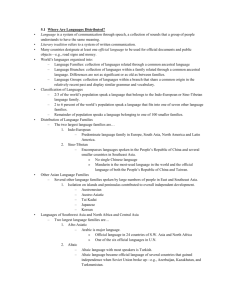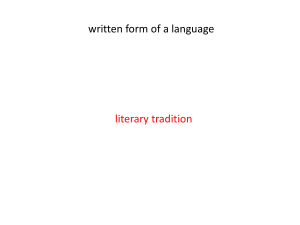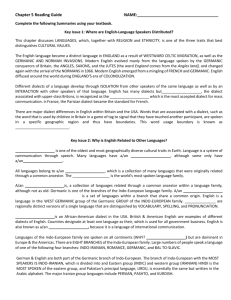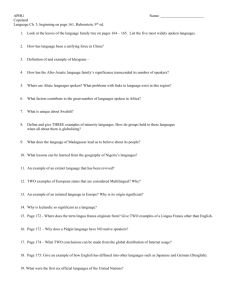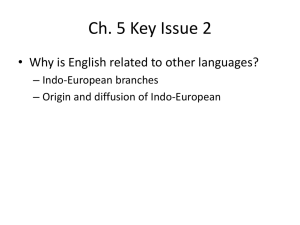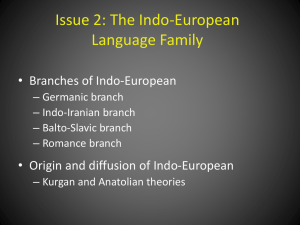Notes - MR. AVERY-BTHS
advertisement
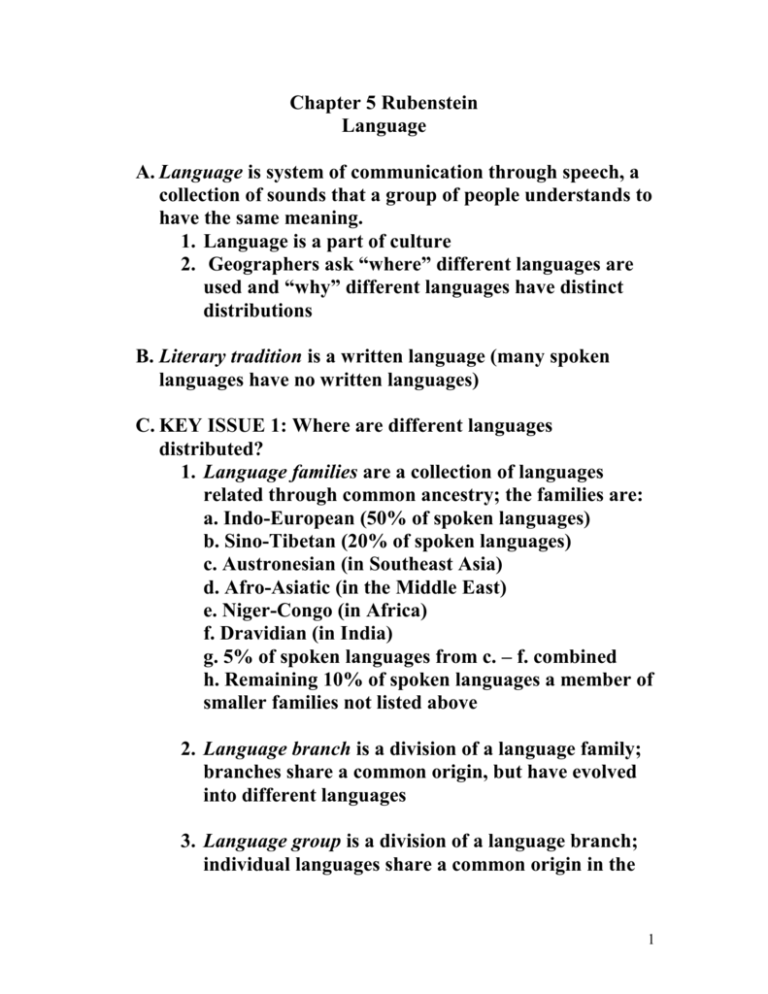
Chapter 5 Rubenstein Language A. Language is system of communication through speech, a collection of sounds that a group of people understands to have the same meaning. 1. Language is a part of culture 2. Geographers ask “where” different languages are used and “why” different languages have distinct distributions B. Literary tradition is a written language (many spoken languages have no written languages) C. KEY ISSUE 1: Where are different languages distributed? 1. Language families are a collection of languages related through common ancestry; the families are: a. Indo-European (50% of spoken languages) b. Sino-Tibetan (20% of spoken languages) c. Austronesian (in Southeast Asia) d. Afro-Asiatic (in the Middle East) e. Niger-Congo (in Africa) f. Dravidian (in India) g. 5% of spoken languages from c. – f. combined h. Remaining 10% of spoken languages a member of smaller families not listed above 2. Language branch is a division of a language family; branches share a common origin, but have evolved into different languages 3. Language group is a division of a language branch; individual languages share a common origin in the 1 relatively recent past and displays relatively few differences in grammar and vocabulary. 4. English belongs to the West Germanic group of the Germanic branch of the Indo-European family 5. Dialect is a form of a language spoken in a certain area distinguished by a regional spelling, vocabulary, and pronunciation – E.G. American and British English 6. Official language is a form of a language used in business, government, education, etc. in areas that speak more than one language 7. Indo-European Language Family: a. More than 3 billion people speak languages of the Indo-European Family b. Branches are: 1). Indo-Iranian 2). Romance 3). Germanic 4). Balto-Slavic 5). Albanian 6). Greek 7). Celtic c. English comes from the Germanic Branch which can be divided into 3 groups: West Germanic, North Germanic, and East Germanic 1). East Germanic group is “extinct” 2). West Germanic group can be divided into 2 sub-groups: High and Low Germanic subgroups 2 a). High Germanic spoken in southern mountains of Germany and is basis for modern, standard German b). Low Germanic is spoken in the northern lowlands of Germany where Angles, Saxons, and Jutes lived, so English comes from the Low Germanic subgroup of the West Germanic Group. 3. North Germanic Group a). Languages from this group are spoken in Scandinavian countries and include Swedish, Dutch, Danish, Norwegian, and Icelandic b). Iceland was colonized in 874AD by Norwegian settlers who developed a literary tradition 1). Due to Iceland’s isolation, original language didn’t change much 2).This is an example of people migrating and taking their language, and hence part of their culture with them 8. Romance language branch a. Derived from Latin b. Latin diffused with Roman Empire c. Latin evolved during reign of Roman Empire 1). “Common” people spoke “vulgar” (masses) Latin they learned from Roman soldiers stationed in various regions of the Roman Empire 2). As provinces grew more isolated from the seat of the Roman Empire, the regional variations in Latin also grew more isolated d. Modern Romance languages are: 1). Spanish 2). Portuguese 3 3). French 4). Italian 5). Languages grew independently due to isolation of each country by mountains which created communication barriers 9. Indo-Iranian language of Indo-European family a. More than 100 individual languages spoken by 1 billion people b. Two groups: 1. Indic (eastern) and 2. Iranian (western) c. Indic group: 1). Languages used in India, Pakistan, and Bangladesh 2). One-third of Indians speak Hindi – written language stays same, but variations on speaking 3). India became independent in 1947 and now 18 official languages d. Iranian group: 1). Spoken in Iran and neighboring countries 2). Languages include Persian (spoken in Iran), Pathan (eastern Afghanistan), and Kurdish 10. Balto-Slavic language branch a. Slavic was a single language, differences developed in 7th century as Slavs migrated from Asia to different areas of eastern Europe and lived in isolation b. Language now divided into 3 groups c. East Slavic and Baltic Slavic: 1). East Slavic languages most widely spoken, primarily in Russia 2). After fall of Soviet Union, more languages besides Russian spoken 4 3). Other East Slavic languages are Ukrainian and Belorusian 4). The two principal Baltic languages are Latvian and Lithuanian d. West and south Slavic groups 1). Most widely spoken West Slavic language is Polish 2). Czech and Slovak also widely spoken 3). Two most important South Slavic languages are Serbo-Croatian and Bulgarian – however, term “Serbo-Croatian” now offensive to both Bosnians and Croatians 11. Sino-Tibetan language family a. Second largest language family spoken by 1/4th of the world b. Languages of China generally belong to Sinitic branch c. No single Chinese language d. Mandarin is spoken by 3/4th of Chinese 1). Mandarin is most used language in world 2). Official language of People’s Republic of China and Taiwan 3). One of 6 official languages of United Nations e. Two smaller branches, Austro-Thai and TibetoBurman spoken in Laos, Thailand and parts of Vietnam and in Myanmar 12. Other East and Southeast Asian language families: a. Japanese b. Korean c. Austro-Asiatic – Vietnamese 13. Afro-Asiatic language family a. Includes Arabic and Hebrew and 5 b. Were used to write the Judeo-Christian Bible and Islamic Quran 14. Altaic and Uralic language family a. Altaic languages thought to have originated in area between Tibet and China b. Turkish is most popular Altaic language c. Uralic languages originated in Ural mountains of Russia d. Uralic languages spoken in Estonia, Finland, and Hungary 15. African language families a. Over 1000 different languages spoken in Africa – more than any other continent b. Several thousand dialects c. Number of languages resulted from at least 5000 years of isolation d. Most lack a literary tradition e. Families include Niger-Congo, Nilo-Saharan, Khoisan (Sub-Saharan Africa), and Austronesian (Indonesia) D. KEY ISSUE 2: Why do people in different locations speak similar languages? 1. Two geographic processes going on: interaction, and isolation 2. People migrate and take language with them 3. If these people become isolated from each other, variations in language usually occurs 4. Origin and diffusion of Indo-European languages a. Indo-European languages have common roots to many words 6 b. Also share many words such as “bee, oak, deer” all saw same animals and plants indicating all came from similar climate c. Indo-European languages had words for “snow and winter” but not “ocean” d. Words like “camel, rice, bamboo” were not included in Indo-European languages but were spoken in other areas e. Can deduce from this that the Indo-European language hearth must have been in a more temperate area away from any oceans f. Two possible hearth areas and origins of Indo-European languages include: 1). Kurgan origin a). These people lived in steppe areas near Kazakhstan and Russia b). Earliest evidence dates back to 4300 BC c). Nomadic herders and among first to domesticate horses and cattle – took language with them as migrated in search of grass for animals d). Used horses to conquer much of Europe and S. Asia 2).Anatolia Origin: a). These people lived in Anatolia (part of Turkey) b). Earliest evidence dates back to 6300 BC c). Mostly farmers and took agricultural practices with them as migrated through parts of Europe and Asia g. Isolated languages: 1). A language not related to a language family 7 2). Isolated languages arise through a lack of interaction with speakers of other languages 3). An example of an isolated language is Basque: a). Pre-dated Indo-European languages b).Basque region in mountains c). Mountainous area kept people isolated 4). Icelandic also isolated and has changed the least of any other Germanic language branch E. KEY ISSUE 3: Why is one language spoken differently in different locations? 1. Migrants are able to maintain some communication with speakers of same language, but also encounter speakers of other languages 2. Variations in same language called dialects 3. If area has more than 1 dialect, usually a standard language which is a well- known dialect used in government, business, education, etc. a). An example is British Received Pronunciation (BRP) 4. Other English dialects include Northern, Midland, and Southern 5. USA and British English have different dialects due to which group colonized what part of USA and to subsequent isolation a). New England was colonized by Northern English colonizers – primarily Puritans b). Mid-Atlantic US was colonized by Germans, Scottish, and Southern Englanders c). Southeastern US was colonized by Northern Englanders of different social classes including deported criminals 6. Isoglossses – geographic areas where certain words are used that are not used nationally 8 7. Two major isoglosses of the Eastern US separate into 3 areas: Northern, Midland, and Southern 8. Certain words used in these areas usually relate to rural life, food, and objects a). “pail” in northern isogloss, “bucket” in southern 9. Also regional pronunciation differences a). “Half” – “ha-af” in Southern isogloss which tends to add syllables b). “ear” – “ea-ah” in Northern Isogloss which tends to drop “r’s” and add “ah’s” F. KEY ISSUE 4: Why do people preserve local languages? 1. Language is subject to both globalization and to isolation 2. Thousands of languages have become “extinct” a. Gothic b. East Germanic group 3. Some languages are being revived – E.G. Hebrew a. Hebrew used to write most of Old Testament of Bible b. Use of Hebrew waned in 4th century AD, but still used in Jewish religious services c. State of Israel established in 1948 and Hebrew became an official language d. Problem: no Hebrew words for things such as “cars, airplanes, computers” etc. e. Eliezer Ben-Yehuda took on the task of “inventing” 4000 new Hebrew words and the creation of a modern Hebrew dictionary 4. Some languages being reserved – E.G. Celtic spoken in England before the invasion of the Germanic Angles, Saxons, and Jutes 5. English is becoming a global language – one used for international communication 9 a). In this sense, English is a lingua franca – an international trade/business language b). Pidgin English is an example of a simplified form of a lingua franca and has no native speakers 6. As a result of its expansion, English is currently changing – adding new words, spellings, and pronunciations a). New word e.g. = “irregardless” 7. English is also being incorporated into other languages: a). “Franglais” – a mixture of French and English where English words are used in France – E.G. – “software, cowboy, jeans, etc.” b). “Spanglish’ – Converting English words to Spanish forms 10
